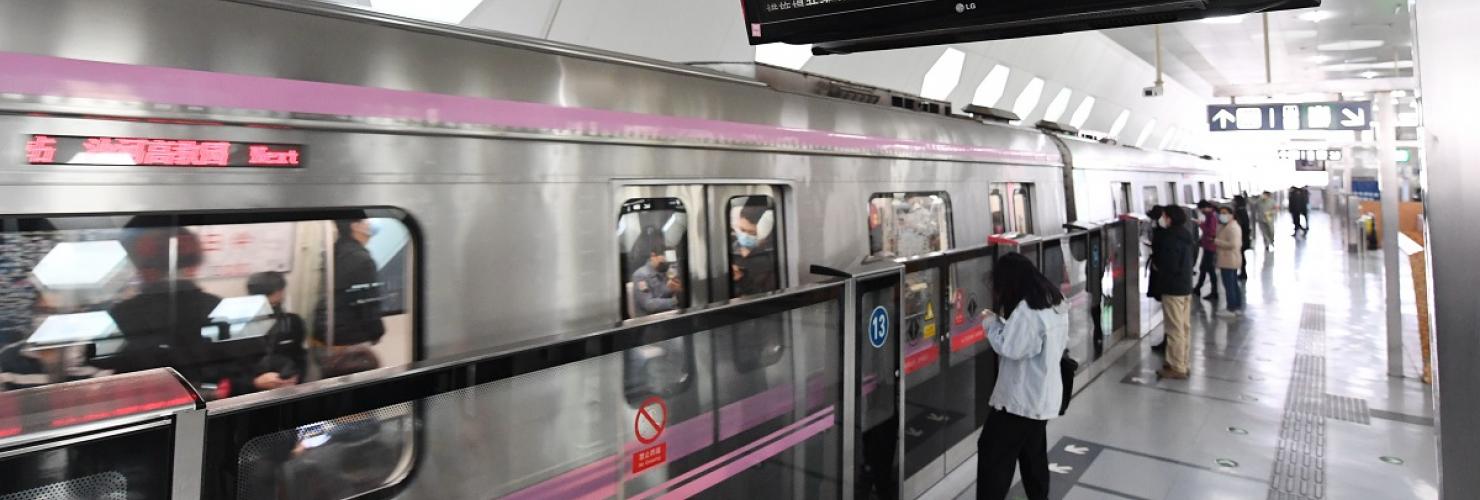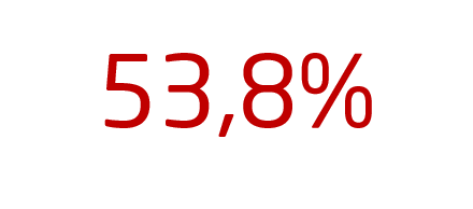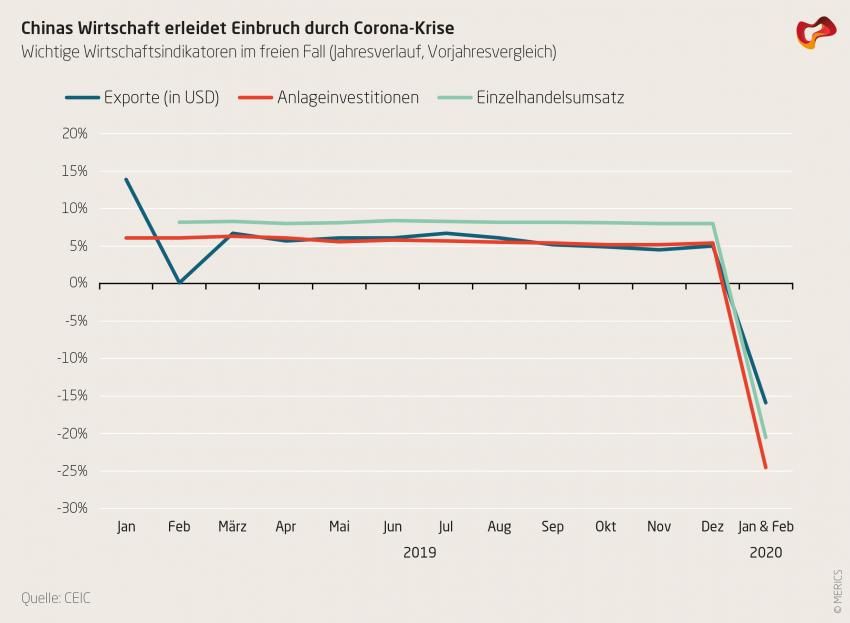

The consequences of corona in China: The end of the crisis is the beginning of the next one
China Update 6/2020
METRIX
A survey of the general public in China reveals that over half the population rated the psychological impact of the coronavirus outbreak as moderate or severe.
Topic of the week: Corona in China
The consequences of corona in China: The end of the crisis is the beginning of the next one
While the number of coronavirus infections worldwide grew to around 428,400 as of Wednesday, just over three months after the outbreak of the epidemic in Wuhan, China has declared that it has more or less overcome the crisis. The number of infections in the country has remained at around 81,000 for several days, according to official sources and the party state media says the epidemic is under control. Just a few days ago, China’s President Xi Jinping visited Wuhan, a first signal of confidence that they are winning the battle. After two months in lockdown, restrictions in Hubei province will be relaxed. Only in Wuhan, which has been worst affected by the coronavirus outbreak, will the tougher restrictions continue to apply until April 8.
These measures at home correspond to China’s appearance of self-confidence abroad. Countries that have been affected by the pandemic, including in the EU, have received medical equipment, donations and other help from China. For example, China has sent doctors to help in Italy. China’s drastic actions to stem the outbreak – lockdowns, digital surveillance – have inspired politicians even in democratically governed countries, although the measures they have taken have not gone quite as far as those in China.
The image of China selflessly providing help to others is, however, clouded by arguments, particularly in social media, about the causes of the disease. The debate between the United States and China is characterized in particularly by allegations of racism and conspiracy theories about the causes of the pandemic. The global efforts to combat the disease are suffering because of these tensions.
In spite of the confidence it is presenting, in China too there is a significant worry that the end of the crisis could be the beginning of the next one: The economy has contracted dramatically in the first quarter as a result of the epidemic and there continues to be a fear that there may be further outbreaks. China’s Premier, Li Keqiang, called on Tuesday for local authorities not to avoid reporting new infections in order only to be able to register a new infection number of “0”. The coronavirus is likely to keep the whole world, including China, on edge for some time to come.
MERICS analysis:
China’s fight against COVID-19 - Clicking for a cure. Blogpost by Kai von Carnap
“WHO has Chinese characteristics?” Blogpost by Thomas Geddes
China and the world
US-China tensions grow amid coronavirus pandemic
As the coronavirus has become a global pandemic, US-China relations have deteriorated over mutual recriminations and conspiracy theories about the cause of the pandemic, and over the competition for effective responses. Aggravating matters, both countries have expelled each other’s journalists in recent weeks. The tensions threaten to undermine effective efforts for a coordinated global response to the crisis.
Even though the United States and China had called a truce in their increasingly difficult relationship by signing a “Phase 1” trade deal in mid-January, the corona virus pandemic has led to a drastic escalation of tensions. Each side now blames the other, including name calling and propagating conspiracy theories about the origins of the virus. The Trump administration provoked angry reactions from Beijing by insisting on calling COVID-19 “Wuhan virus” or “China virus.” On the other side of the fence, conspiracy theories circulated in China that it was the US military that brought the virus to China.
Despite heightened tensions around blame for the pandemic, there has been a range of more level-headed responses by some Chinese and Americans in recent days. China’s ambassador to the US, Cui Tiankai, explicitly criticized virus-origin conspiracy theories while in the US. Other prominent US-China relations voices have called for pragmatic cooperation between US and Chinese scientists and businesses to find and implement effective solutions to the crisis.
MERICS analysis: “The descent into acrimonious recriminations by US and Chinese officials is doing neither country nor the international community any good. Yet being on the precipice of a more fundamental breakdown of US-China relations has already begun to focus minds in both countries on how to find practical solutions to a truly global crisis.” Matt Ferchen, Head of Global China Research at MERICS
“Mask diplomacy”: China tries to project soft power by supporting pandemic-stricken countries
Chinese state and non-state actors, foundations and companies are sending exports and donations of medical equipment to European countries hit by the coronavirus outbreak. The Jack Ma and Alibaba foundations, Chinese tech companies Huawei and Xiaomi, the Chinese Red Cross and others have provided surgical masks, protective suits, testing kits and lung ventilators for intensive care units. Chinese medical doctors also arrived in Italy to help.
However, these donations have come under scrutiny against the backdrop of Beijing’s campaign to shape the global narrative on the coronavirus outbreak. Beijing aims to divert attention away from the Chinese government’s initial cover-up of the epidemic, which delayed the international response to what is now a pandemic.
China wants to project its soft power abroad by promoting itself as a model for handling health emergencies. Official Chinese statements have also been glossing over the fact that at least part of what is reaching Europe are not donations, but exports of medical supplies purchased by European countries.
Some Eurosceptic leaders very explicitly welcomed the support from China and pointed to what they perceive as a lack of support from the EU. Serbian President Aleksandar Vucic even kissed the Chinese flag when a batch of supplies arrived from China, calling European solidarity “a fairytale.” Serbia received a 7.5 million EUR donation from the EU amid the spread of the coronavirus.
EU High Representative Josep Borrell acknowledged that there is a “global battle of narratives going on” on the coronavirus, which sometimes extended to discrediting the EU: “There is a geo-political component including a struggle for influence through spinning and the ‘politics of generosity.’”
News in brief
- US journalists: NYT, WSJ and WP respond in open letter to expulsions from China
- EU-China Summit – Meeting between leaders planned for March 2020 postponed by coronavirus
- Pakistan-China relations – President Alvi visits China amid COVID-19 pandemic
Politics, society and media
Politics of numbers: Safeguarding “zero” new infections
For days China has reported zero new domestic transmissions of COVID-19, a streak that was only broken on Tuesday by four new cases. The message, however, remains clear: everything is under control. The government seems eager to return to business as usual and restart the economy. According to Reuters an editorial in the official China Daily argued that maintaining stringent restrictions on people’s movements would “now do more harm than good”.
The low number of infections is not unproblematic, though. For one, the government’s stance that officials and company owners will be held responsible should new cases arise, is a dangerous incentive to pass the buck. Kyodo News and RTHK reported the premature release of quarantine patients and a reduction in the number of tests done in Wuhan leading up to and following the visit by state and party leader Xi Jinping, possibly resulting in underreporting of cases.
In addition, the low number of domestic transmissions reflects “confirmed” infections only. Chinese regulations mandate that asymptomatic patients and recovered patients who test positive again do not count towards the tally, even though they are contagious. How big this figure is, is unclear, but evidence from other countries suggests it is significant. Creating a false sense of security can be dangerous at the current stage.
In a sign that the Chinese government itself is becoming concerned about politically motivated overly optimistic numbers, Premier Li Keqiang has this week gone on record warning that people in charge should not fail to report cases in pursuit of the number zero.
However, based on official statistics to date, the total number of new infections consists mostly of so called “imported infections”, brought into China by international travelers and Chinese returning home. Should a second wave of infections hit the country, the failures of the West to prevent a reimport into China would be a more welcome narrative than another failure to look close enough domestically.
MERICS analysis: “With domestic and international scrutiny of China’s crisis management, and its attempt to present itself as the most capable system to battle the virus, case counts have become a political item. The low number of new infections is best seen as an indicator, not as the actual number,” says MERICS expert Nis Grünberg.
China turns to Russian tactics in disinformation over corona
The Chinese government and party-state media have been pushing conspiracy theories about the source of the corona crisis via Twitter. The tactic is markedly different from previous attempts to influence global opinion and suggests the Chinese government is keen to use any means to deflect criticism. Swedish Defense Minister Peter Hultqvist warned of Chinese and Russian disinformation tactics.
While Chinese media, diplomats and embassies have become accustomed to using Twitter and have sent out misleading information in the past, spreading conspiracy theories that COVID-19 originated in the United States and Italy represents a step change in its tactics – one that more closely resembles the disinformation tactics used by Russia.
Ministry of Foreign Affairs spokesperson Zhao Lijian has been the most aggressive in pushing these conspiracy theories on social media. However, he is not alone. Similar stories have appeared in the Global Times and state-run English language television network CTGN.
Zhao appears to have toned down the message after the Chinese ambassador the United States, Cui Tiankai, gave an interview in which he disavowed the idea that the virus could have originated in the US. The messages now coming from him and other sources out of China are more conciliatory, emphasizing Xi Jinping’s “community of shared future” and China’s cooperative approach to the rest of the world.
MERICS analysis: “It looks very much like this tactic comes from a desire to deflect blame for the coronavirus pandemic. The change of tone is not a U-turn; it is part of the same strategy. The cooperation message may be working better for them right now, but the original messages have neither been retracted nor deleted. Key accounts like Zhao’s and the Global Times should be monitored for similar attempts in the future to push the Party’s domestic messaging abroad more aggressively,” says MERICS expert Mareike Ohlberg.
Economy, finance and technology
China’s economy hit hard by response to coronavirus
China’s economy looks set to contract sharply in Q1 as a result of its response to the coronavirus. GDP figures will not be released until April, but the data available so far points to a significant downturn. While Wuhan was in lockdown, the rest of the country largely stayed at home. The effects of those measures are now being felt on each of the components that make up GDP.
For the year to date, retail sales have fallen by 20.5 percent, fixed asset investment by 24.5 percent and exports by 15.9 percent. Meanwhile, imports fell by just 2.4 percent meaning there will be a very negative impact on net exports.
Further evidence comes from surveyed unemployment, which has risen from 5.2 percent in December to 6.2 percent today - the highest number on record. Manufacturing and non-manufacturing Purchasing Managers’ Index are also down, from 50 and 54 respectively, to 35.7 and 29.6. Any number below 50 in PMI indicates a contraction.
However, the clearest indicators of all that the slowdown is real - and the ones that best capture the big picture - are air pollution and electricity consumption. Satellite images show Chinese air pollution has fallen drastically, and latest figures reveal that electricity consumption has fallen by 10.1 percent, indicating economic activity is severely reduced.
The only part of the Chinese economy that has apparently not been severely impacted is the stock market. But given that there has been around a 20 percent fall in economic activity, this reflects not so much underlying reality, as the fact that the government has intervened heavily to defend asset prices.
China now has to restart its economy quickly. Many fixed costs such as rent and mortgage payments will not be met if companies and individuals lose their income. This will not be easy, however. China was already financially rather shaky before the corona crisis hit, and it now faces the added challenge that the virus has spread to the rest of the world. With consumption decreasing around the globe, China’s exports sector will struggle to get back on its feet. In 2019, net exports were an important contributor to China’s economic growth.
For Europe, which to some extent is copying China’s response to the crisis with severe social distancing, restrictions and closures, the economic costs in China give an indication of the scale of the impact these measures could have on its economy.
China supports strategic ‘favorites’ amid coronavirus crisis
China’s special treatment of select companies during the coronavirus lockdown demonstrates the government’s focus on promoting technological development in strategic sectors – even in times of crisis.
Semiconductors and new energy vehicles are industries in which China wants to become a global leader at all cost, even if that means risking virus transmissions or investing large amounts of resources to keep the companies that are at the helm of these industries running.
China’s local and central governments went to extreme lengths to enable one of the country’s posterchild chip companies, Yangtze Memory Technology Company (YMTC), to keep operating in Wuhan throughout the lockdown. YMTC received special permissions to bring in employees and materials, and to ship finished goods out of Wuhan.
The US company Tesla, which plays a leading role in driving China’s e-mobility sector, also received significant government support in the form of protective materials such as disinfection or facial masks and specially arranged dormitories and transport for employees. This allowed it to swiftly restart its Shanghai factory on February 10.
Simultaneously, the NDRC announced it will accelerate the development of “new infrastructure” such as 5G networks, data centers and smart cities. As China’s economic activity comes back to life the government will likely continue concentrating on ensuring that strategic technology sectors stay on track to meet its targets. However, despite these support efforts, the next months may still reveal setbacks in strategic sectors, especially among smaller companies that are not the main focus of government attention.
News in brief
- Car industry amid corona – production slowed in Europe, but suppliers see rebound for China output
- AI to solve crisis - Chinese government launches new tech database to fight the coronavirus
- COVID-19 impact - China’s supply-side shock is rapidly becoming a demand-side one
- Favorable loans - Big state-owned banks cut rates for consumer loans in response to coronavirus
Profile
Zhao Lijian: China’s aggressive Twitter diplomat
As the spokesperson for China’s Ministry for Foreign Affairs, Zhao Lijian should be able to combine clear words and diplomatic skills. However, in tackling the Coronavirus crisis, the 47-year old career diplomat may have overstepped the mark. Via his Twitter account, which has attracted almost half a million followers, he helped push a conspiracy theory circulating on Chinese social media that it was the US army that brought the dangerous virus to Wuhan.
“When did patient zero begin in the US?” Zhao asked on Twitter, which is blocked in the People’s Republic, and went on demanding “transparency” from US President Donald Trump: “You owe us an explanation,” he said. It can be assumed that Zhao’s undiplomatic outbursts have Beijing’s approval in times, when the leadership in Beijing is struggling with criticism for mishandling the outbreak in the early stages. Zhao is an experienced Twitter user, who relishes launching blunt attacks on China’s critics.
Zhao was one of the first Chinese diplomats to open an official Twitter account. His start of his social-media career coincided with a second official posting to Pakistan – for four years he was deputy envoy at the Chinese embassy in Islamabad. As a Foreign ministry spokesperson, he has continued tweeting daily on current events using a style reminiscent of Trump himself.
His bold approach to the Corona topic, however, seems to displease some of his colleagues. China’s ambassador to the US, Cui Tiankai, has openly criticized the conspiracy theories Zhao helped to spread as crazy and damaging. Zhao is now trying to tone down his rhetoric on Twitter and has reverted to diplomatic lingo, but only shortly afterwards, he hit back at the US’s use of the term “China virus”, calling it racist. It seems clear that China’s aggressive Twitter diplomat has no intention of retiring.

